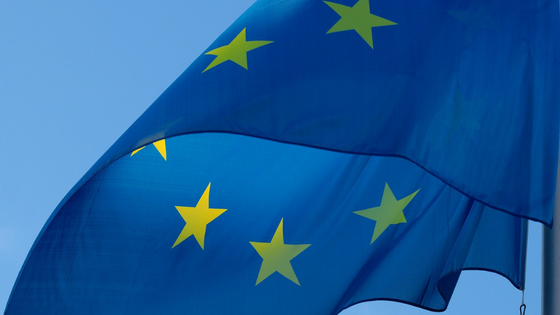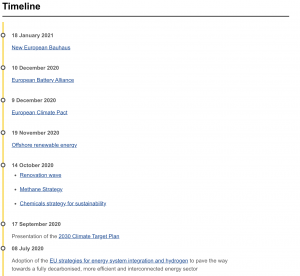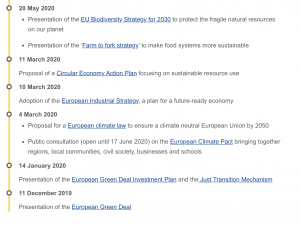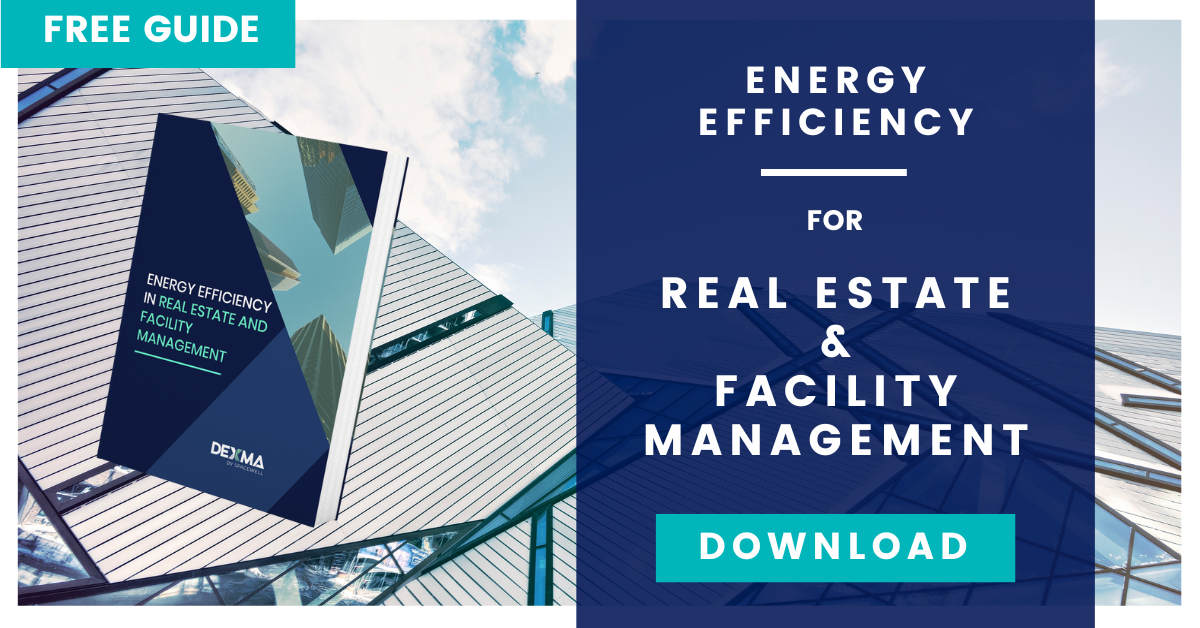What is the European Green Deal?
To understand a little better what the European Green Deal is and what it consists of, let’s go back in time. The European Green Deal was created in December 2019, just a few months before the state of alarm and the global pandemic was declared (this is important, as it will have an impact on the deal in 2020). This comes as a consequence of the still unresolved climate problems at both European and global levels.
Although the European Commission has been creating different regulations and directives concerning the fight against climate change (e.g. Energy Efficiency Directive) in the last decades, this new pact is a step further towards sustainability.
Its main objective is for Europe to become a climate-neutral zone by 2050, the worldwide leader in sustainability and green economy. What does this mean? It means that Europe must continue to reduce its greenhouse gas emissions, tackle a green transition of the manufacturing sector, transform the energy system to a clean energy one, protect biodiversity, etc. by 2050.
Note: Greenhouse gases are not only CO2 but also gases such as methane and nitrogen oxide.
To achieve this goal, the European Green Deal sets out a roadmap for us to follow, based on actions that promote a clean and circular economy, reverse the loss of biodiversity and reduce pollution.
In addition, the climate urgency has been compounded by a further challenge in the form of the health and economic crisis caused by the global pandemic covid-19. The consequence of this was that in 2020 the actions and strategies to be carried out during the Green Deal roadmap were also focused on the economic reconstruction of Europe: based on a circular, sustainable and energy-efficient economy.
Goal: Climate Neutrality by 2050
As we said, the goal is to reach climate neutrality by 2050. We know it is a very ambitious target and that is why the European Green Deal sets out an action plan which needs to involve all sectors of the economy:
- Investing in environmentally friendly technology,
- Encouraging innovation in the industry,
- Transforming the public and private transport system into a cleaner, cheaper and healthier mobility system,
- Decarbonising the energy sector,
- Converting buildings into more energy-efficient and energy-smart facilities,
- And working with international partners to improve global environmental standards.
According to Commissioner Ursula Von der Leyen: “It must be a green, digital and climate-resilient future”. So, Digital and Energy Transitions are key.
On the other hand, Frans Timmermans, executive vice-president of the commission, made it clear that: “… our responsibility is to make sure that this transition is a just transition, and that nobody is left behind as we apply the European Green Deal“.
And to achieve this, €1 billion will be mobilised over the next decade for innovation projects in all sectors of the economy, especially transport, energy, agriculture, buildings and industry (steel, cement, ICT, textiles and chemicals).
The call funded under the H2020 framework, which ended last January, will boost the recovery of Europe due to the coronavirus crisis, for a transition to a green, low-carbon economy. “The secret: turning green challenges into opportunities for innovation”.
The European Green Deal Roadmap: The 8 Key Pillar
The roadmap set out in the European Green Deal started in December 2019, and since then, decisions have been already taken and strategies established for the 8 main pillars of the pact:
1. Climate change: increasing climate ambition.
2. Clean energy. Working on an energy transition that:
-
- Boosts energy efficiency.
- Ensures an affordable and secure energy supply system.
- Transforms the energy market into a digitised, integrated and interconnected market.
3. Industry, where innovation is based on a clean and circular economy.
4. Buildings: Build and renovate. 40% of energy is spent on constructing and maintaining buildings. Initiatives here are mainly aimed at improving the energy efficiency of buildings and their resources, through the construction and renovation of the EU building portfolio.
5. Sustainable and smart mobility. ¼ of greenhouse gas emissions come from transport, whether private or public. Here the Green Deal aims to reduce 90% of greenhouse gas emissions from transport by 2050. To this end, innovation and improvement of public transport and EVs (electric vehicles) will be promoted by providing the necessary infrastructure for sustainable and intelligent mobility.
6. From farm to fork. This is the intuitive name given to the strategy focused on the EU’s food system. Its aim is to achieve a healthier and more sustainable food system that protects both the planet and our health.
7. Biodiversity and ecosystems. The strategy here aims at putting Europe’s biodiversity on the path to recovery by 2030, taking direct action to protect and restore ecosystems.
8. Zero-pollution, toxic-free environments. The European Commission wants to fight air, water and soil pollution, especially the one caused by microplastics and chemicals.
Here you will find the chronology of actions taken by the European Commission so far. They all set deadlines for legislative measures and concrete targets to support change.
We would like to highlight the following ones:
- On the one hand, the European Climate Law that was presented in March 2020, which objective is to guarantee the climate neutrality of the European Union by 2050, as it turns the political commitment of the Member States into a legal obligation.
- On the other hand, the definition of the strategies for energy system integration and hydrogen in July 2020, to obtain a fully decarbonised, more efficient and interconnected energy sector.
- Also, the presentation September 2020 of the 2030 Climate Target Plan is expected to reduce 55% of greenhouse gas emissions by then.
- And finally, the European Climate Pact in December 2020, which includes a European industrial strategy and a circular economy action plan. This pact will launch an online tool where any European citizen or organisation can become an ambassador of the Climate Pact (if you would like to be one of them, you will find all the information here).
How the European Green Deal affects the energy management of buildings and facilities
As you have seen, the great European Green Deal affects practically all sectors and aspects of our daily lives, with the proposal of new industrial, mobility and building models.
In this particular section, we will focus on one of the main pillars, “Sustainable construction and renovation of buildings”, as it affects the efficient energy management of buildings, one of the main topics of the blog.
And how will this be achieved? The main objective of this point is to achieve green and sustainable buildings and cities by requiring member states to pass legislation on energy efficiency in construction and energy renovation of buildings. In other words, your buildings or your clients’ buildings will have to meet energy efficiency requirements.
This is a great opportunity for the recovery of sectors such as construction, real estate, facility management, and energy service companies. So, being at the forefront of energy-efficient management services and strategies from now on will not only be an obligation but also an economic opportunity.
Thus, how do I make my buildings or my clients’ follow the roadmap of the Green Deal, and achieve the required energy efficiency? We give you some guidelines to follow:
1. Get up to date on energy efficiency and sustainability legislation. Search your country’s official website for energy efficiency regulations; for example, in the case of the UK, you can find all the information here. We also recommend that you keep up to date with the different European directives and regulations.
2. Implement efficient energy management policies in your organisation, such as ISO 50001. This type of certification will help your organisation or your customers to identify the most energy-consuming activities, standardise energy management processes, improve best practices, and you will have guidelines to follow to apply new energy-efficient technologies.
3. Obtain sustainable design certifications for your buildings: BREEAM, LEED, WELL and Passivhaus. These certifications are ideal to follow a strategy that helps to improve energy management, reduce waste and therefore improve the sustainability of buildings.
4. Work with advanced energy management tools. Working with a good tool specialised in efficient energy management is essential to get the best results. With integrated platforms such as Dexma Energy Intelligence, for example, you will have the opportunity to:
- Detect energy-saving opportunities in your buildings without leaving the office. This AI-powered tool automates your audits by segmenting your building portfolio into savings opportunities and disaggregating consumption with NILM monitoring models.
- Analyse at the same level as the most advanced professionals thanks to real-time monitoring, savings control and verification, the creation of customised reports, and many other functionalities that you will find in its AppMarket.
- Optimise energy management processes with the automation of energy data analysis 24/7, and the detection and tracking of anomalies caused by energy consumption.
If you want to learn more about energy management for buildings, the sector’s challenges, how to analyse consumption, and find out more useful tools in this regard, download the free specialised Guide for Real Estate and Facility Management available in pdf.







